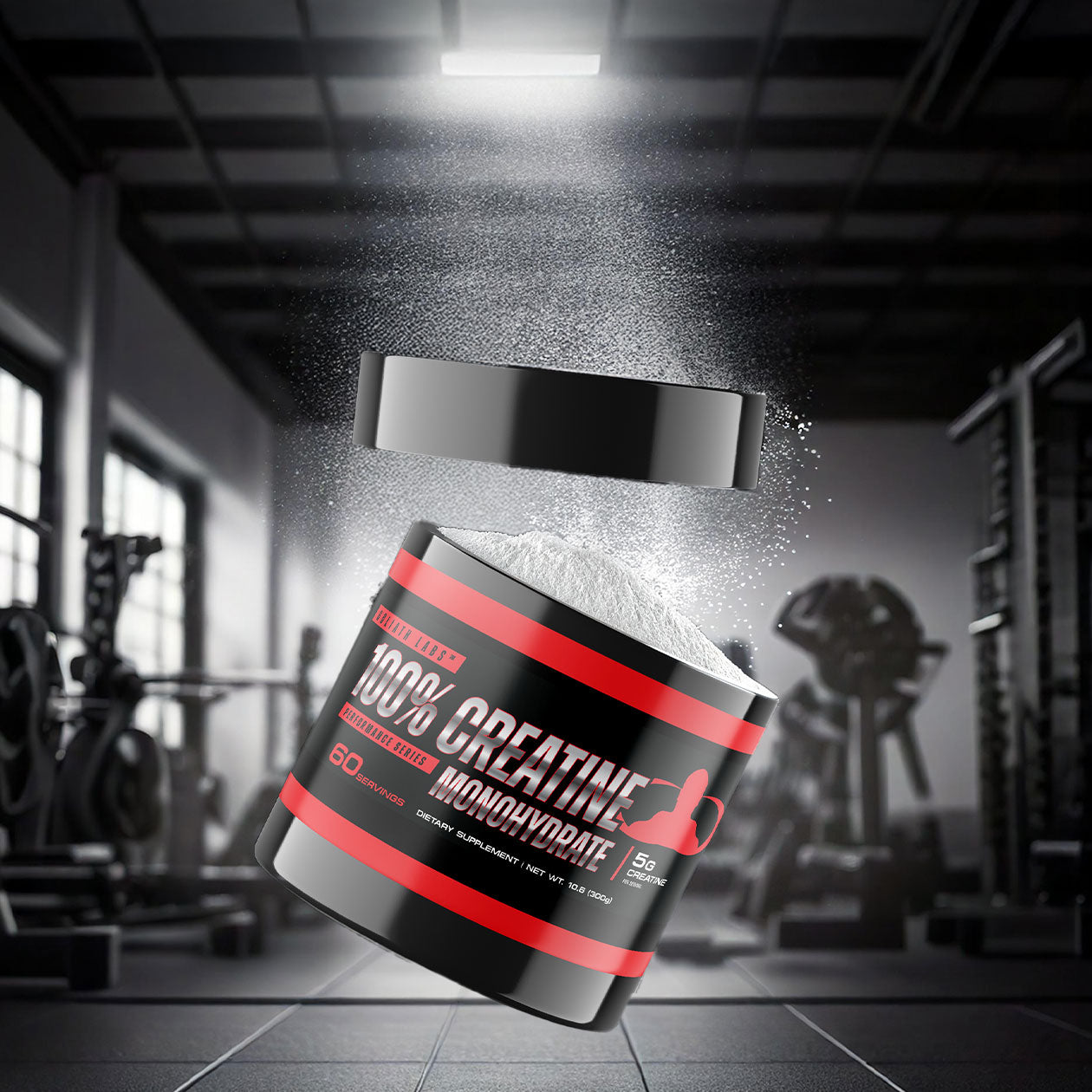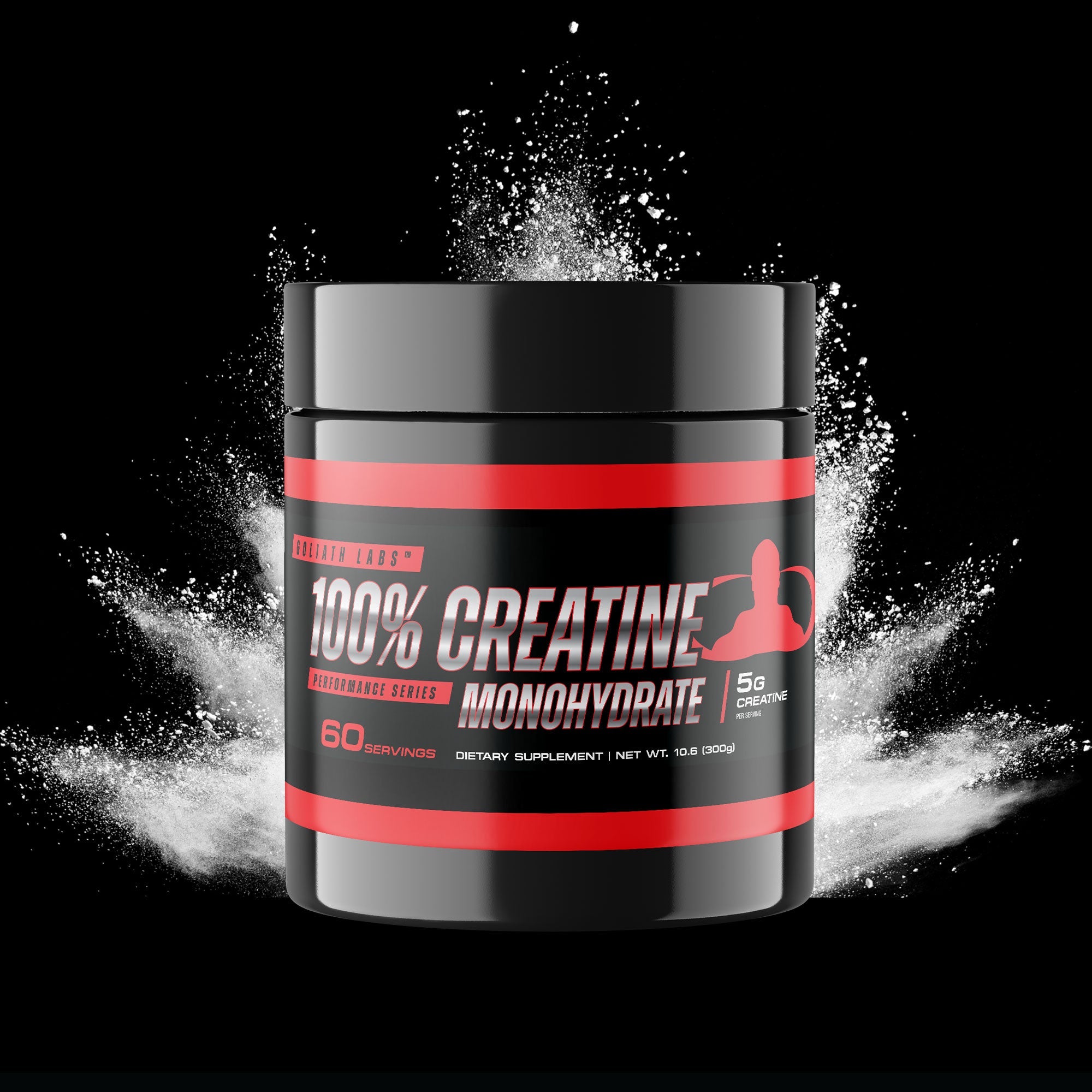No, creatine doesn’t make you gain belly fat. Any increase on the scale is likely from water pulled into your muscles, not actual fat. Creatine has zero calories and doesn’t affect fat storage. In fact, it helps preserve lean muscle, supporting better body composition over time.
A lot of people think creatine makes you gain belly fat. It doesn’t.
What it can do is make your muscles hold more water, which might make your stomach feel fuller or your clothes fit tighter at first. That’s not fat, it’s hydration inside your muscle cells, and it’s temporary.
Creatine doesn’t have calories, and it doesn’t change how your body stores fat. In fact, it can help you burn more by letting you train harder and keep your muscle during a cut.
At Goliath Labs, we’ve been making high-quality creatine for over 20 years, so we know what creatine actually does to your body and how to use it without stressing about your waistline.
The Creatine Confusion: Why This Myth Won’t Die
Somewhere along the way, creatine got a reputation for making people look soft, especially around the midsection. It’s one of the most common concerns we hear: “Will this make me gain belly fat?”
That worry usually comes from what happens early on. A few days into taking creatine, the number on the scale jumps. Your stomach might feel tight. Your shirt fits fine, but your waistband doesn’t.
That sudden shift has nothing to do with fat.
What’s happening is water moving into your muscles, a normal and expected effect of creatine. Still, because the change shows up fast and feels unfamiliar, people assume the worst.
The myth stuck because it felt true. For beginners especially, the signs, weight gain, softer lines, a puffier look, felt like fat gain.
But none of that comes from added body fat. It’s just water held inside the muscle where it boosts performance and recovery.
What Creatine Does in the Body?
To understand why creatine doesn’t lead to belly fat, you need to know what it actually does.
Creatine isn’t a fat burner or a weight gainer, it’s a fuel extender. It helps your muscles produce short bursts of energy, especially during high-effort activities like lifting, sprinting, or pushing through that last set.
This extra energy lets you work harder, build more muscle, and recover faster, all without changing how your body stores fat. But to do its job, creatine draws water into your muscle cells, and that’s where the confusion starts.
How Creatine Fuels Your Muscles
Every time you contract a muscle, your body uses a chemical called ATP (adenosine triphosphate). It’s your fast-acting energy source, sort of like lighter fluid for your muscles.
The problem? Your body runs out of ATP in seconds during intense effort.
Creatine helps refill those stores. When creatine enters your muscle cells, it binds with phosphate to form phosphocreatine. That compound helps regenerate ATP quickly so your muscles can keep working at high intensity.
Whether you're benching 200 pounds or hauling boxes on a double shift, creatine helps you push harder without burning out as fast.
The Role of Water Retention
Creatine pulls water into your muscles, not under your skin.
This is called intramuscular water retention, and it’s completely different from the bloating caused by salty foods or inflammation. Some people notice a “fuller” or “puffed-up” look, especially in the first week, but that’s muscle hydration, not fat gain.
In fact, hydrated muscles function better.
They recover faster, feel less sore, and perform with more endurance. That slight increase in scale weight? It’s a signal that the supplement is working, not a sign you’re gaining fat.
Does Creatine Contain Calories or Increase Fat?
No, creatine does not contain calories, and it doesn’t cause your body to store fat.
Fat gain happens when you eat more calories than your body needs. Period.
Whether those extra calories come from protein, carbs, fat, or alcohol, they get stored as body fat when they aren’t used for energy. Creatine doesn’t provide energy in the form of calories, it supports how your body uses energy, especially during high-intensity effort.
So why do some people feel like they’re gaining fat, even while sticking to a clean diet?
It comes down to perception. When creatine pulls water into the muscles, it can make your stomach feel tighter or less defined.
That’s especially noticeable if you’re already lean or paying close attention to how you look in the mirror. But that feeling has nothing to do with fat gain, and everything to do with hydration shifts inside the muscle.
If the scale goes up or your abs don’t pop as much, it’s easy to panic.
But stick with it. The “bigger” look is short-term, and as you build strength and muscle, your body composition improves. What you’re seeing is performance setting the stage for better results, not fat.
The Bloat Effect: Is It Real and Should You Worry?
Yes, the bloat is real, but it’s not what you think.
When you start taking creatine, it’s normal to gain 2 to 5 pounds in the first week. That weight comes from water, not fat, and it’s pulled into your muscle cells, not under your skin. The effect is called intracellular water retention, and it’s a sign the creatine is doing exactly what it’s supposed to.
Still, that sudden shift can catch people off guard.
Your midsection might look softer. Abs might fade. Some people even notice their jeans feeling tighter around the waist. That leads to the classic worry: “I’m eating clean, so why do I look heavier?”
Here’s the answer: you’re not storing more fat. You’re holding more water inside your muscles.
It’s temporary, it’s harmless, and it often goes unnoticed after the first few weeks, especially as your strength and training volume increase.
This isn’t the same kind of bloating you’d get from junk food or poor digestion. It’s functional, performance-driven hydration.
Creatine While Cutting: Yes, It Makes Sense
Many people avoid creatine during a cut because they assume it’s only useful for bulking.
That’s a mistake. Creatine isn’t a mass gainer, it’s a performance enhancer. And during a calorie deficit, when your energy and strength naturally dip, creatine becomes even more valuable.
Cutting requires your body to burn more calories than it consumes.
That process often leads to muscle loss along with fat, especially if you’re training hard. Creatine helps counter that. By supporting ATP regeneration, it allows you to maintain higher workout intensity even when you’re eating less.
That helps you preserve lean muscle, one of the most important factors in keeping your metabolism high.
Muscle retention during a cut isn’t just about performance, it shapes how your body looks.
Losing fat while holding on to muscle creates sharper definition, tighter abs, and a leaner waistline. It’s the difference between “skinny” and “fit.”
Adding creatine to your cut won’t slow down fat loss.
In fact, it gives your body a better chance of holding onto the muscle that keeps you strong and lean. If your goal is a flatter stomach and improved body composition, creatine isn’t just okay, it’s one of your best tools.
How to Minimize Bloating While Still Using Creatine
If you’re concerned about looking bloated while taking creatine, the good news is, you can easily manage it. Bloating from creatine isn’t caused by fat gain or digestive upset; it’s the result of water shifting into your muscles.
But how you take creatine, and how you support it, can make a big difference in how your body responds.
Smart Dosing Tips
The biggest mistake most beginners make is starting with a loading phase, usually 20 grams per day for 5–7 days. While this quickly saturates your muscles with creatine, it also increases water retention and the likelihood of bloating.
If you want a smoother experience, skip the loading phase.
A steady daily dose of 3–5 grams is just as effective over time and far easier on your system. You’ll still get all the performance benefits, just with a gentler ramp-up and fewer visual changes.
Hydration & Diet Hacks
Proper hydration is critical.
When your muscles start holding more water, your overall fluid balance shifts. To keep things moving smoothly, increase your water intake.
Aim for at least 3–4 liters per day, and consider adding electrolytes, especially if you’re training hard.
Also, watch your sodium and carb intake. High sodium can increase extracellular water retention, which can lead to puffiness under the skin. Similarly, high-carb meals can cause your body to store extra water with glycogen.
Want a cleaner approach?
Our micronized creatine mixes easily, absorbs quickly, and is designed to minimize bloating.
When paired with a well-balanced diet and steady hydration, it offers strength and endurance without the puff.
Why Creatine May Help You Lose Belly Fat in the Long Run
Here’s the part that often gets overlooked: creatine can actually help you lose fat over time, including stubborn belly fat. It doesn’t burn fat directly, but it sets the stage for your body to become better at it.
First, creatine improves your workout intensity. By boosting ATP production, it allows you to lift heavier, push harder, and get more out of each session. That means more total effort and more calories burned, both during and after training.
Second, creatine helps you build and preserve lean muscle.
Muscle isn’t just for looks, it’s metabolically active. The more you have, the higher your basal metabolic rate, which is the number of calories your body burns at rest. So even when you’re not working out, a more muscular body burns more energy.
Combine both effects, stronger workouts and more muscle, and you’ve got a formula for long-term fat loss. And because creatine helps you hold onto strength during a cut, it supports fat-burning without costing you the lean definition you’re working for.
In short, creatine doesn’t make your body store fat.
It makes your body better at building muscle, training harder, and burning more calories. It’s not the problem, it’s part of the solution.
Look Beyond the Scale, Trust the Process
Creatine doesn’t cause belly fat. The weight you may see or feel is water inside your muscles, fueling strength, not storing fat.
Used consistently, creatine helps you train harder, hold onto lean muscle, and improve long-term body composition.
If you're ready to try creatine without the bloat, go with a formula that works with your body, not against it.
You can find affordable creatine monohydrate and a few more supplemental products to help with your body transformation at Goliath Labs website.



